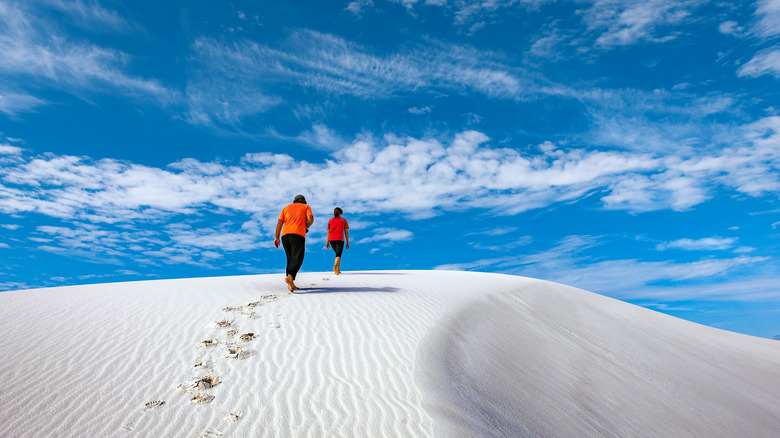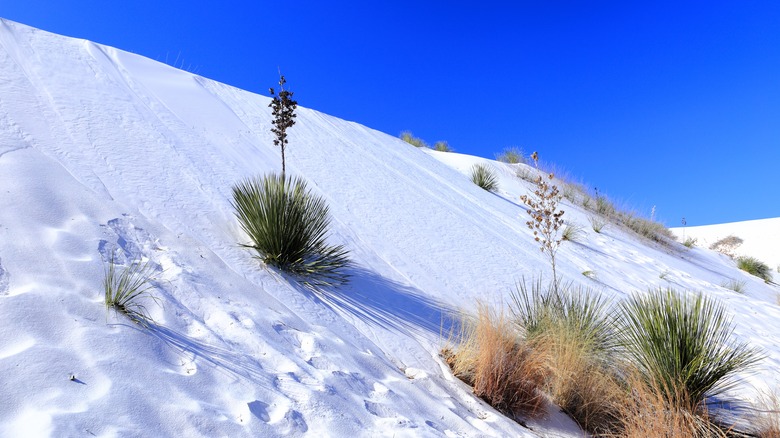The Best Time To Visit This Stunning US National Park With White Sand Isn't What You'd Expect
You can discover gorgeous beaches on tropical islands, but did you know that rural New Mexico is home to a stunning white sand park where you can kick your shoes off, relax, and even sled? Visiting White Sands National Park any time of year can make for a unique vacation, and the best time to visit this otherworldly gem is during the winter months.
In the heart of the Tularosa Basin, White Sands National Park spans 275 square miles of white desert and dune fields. Even when New Mexico's summer heat is unrelenting, the sandy dune fields at White Sands National Park stay cool to the touch. This is because the sand at the national park is composed of fine particles of white gypsum — a soft, translucent mineral that brilliantly shines under both sunlight and moonlight. "It's like you're [on] another planet," Eugene Ibarra, a park ranger at White Sands National Park, told NPR.
This stunning park may appear barren initially, but it brims with plants and wildlife. Interestingly, the dune fields are home to 45 endemic species, with about 40 being moths. Open year-round, except Christmas Day, there are several reasons why you should consider journeying to White Sands National Park when winter rolls around.
Why winter is an ideal time to visit
Given the striking landscape, it shouldn't be surprising that White Sands National Park is the most visited national park in New Mexico and attracted over 782,000 visitors in 2021. To beat the crowd, plan your trip to White Sands during the quieter winter months. Since the colder time of year is the off-season, the trails and park will be less busy.
Not only will you discover that White Sand National Park is more secluded in winter, but also that it cools down. From December through February, daytime temperatures in this Southwestern U.S. park tend to be between 50 to 60 degrees Fahrenheit. That said, you still need to pack winter gear: After the sun goes down in the evenings, the temperature averages around 23 degrees Fahrenheit.
Further, the overall weather conditions can be less volatile during winter. From March through May, strong windstorms routinely impact the sandy dune field. Early July into late September is considered the rainy season at the park, and you're almost guaranteed to get caught in a thunderstorm in the late afternoon or evening. Though rare, winter storms can pass through White Sands National Park, leading to light snowfall or rain.
Things to do at White Sands National Park
The trip to White Sands National Park is worth it for sightseeing alone, but the park offers much family-friendly fun. Sledding down the soft, glistening dunes is a quintessential activity. You can bring your sled or purchase a snow saucer at the park's gift shop. In addition to sledding, daytime hiking and picnicking are popular among parkgoers. White Sands has 9 miles of trails that nature enthusiasts can explore. Walking across the snow-like dunes, you'll pass cacti, brightly-colored succulents and wildflowers, tall grasses, and even trees.
Staying in the park after dark or gaining early admission requires a special use permit, but the extra fee is worth it. In the morning, you can snap pictures of the park's incredible sunrise. After the sun goes down, White Sands offers even more awe-inspiring views. Designated as an International Dark Sky Park, White Sands National Park is a breathtaking spot to go stargazing. Since light pollution is minimal, it's common to observe famous constellations and the Milky Way on clear, moonless nights. This winter, head to White Sands for an unforgettable experience.


